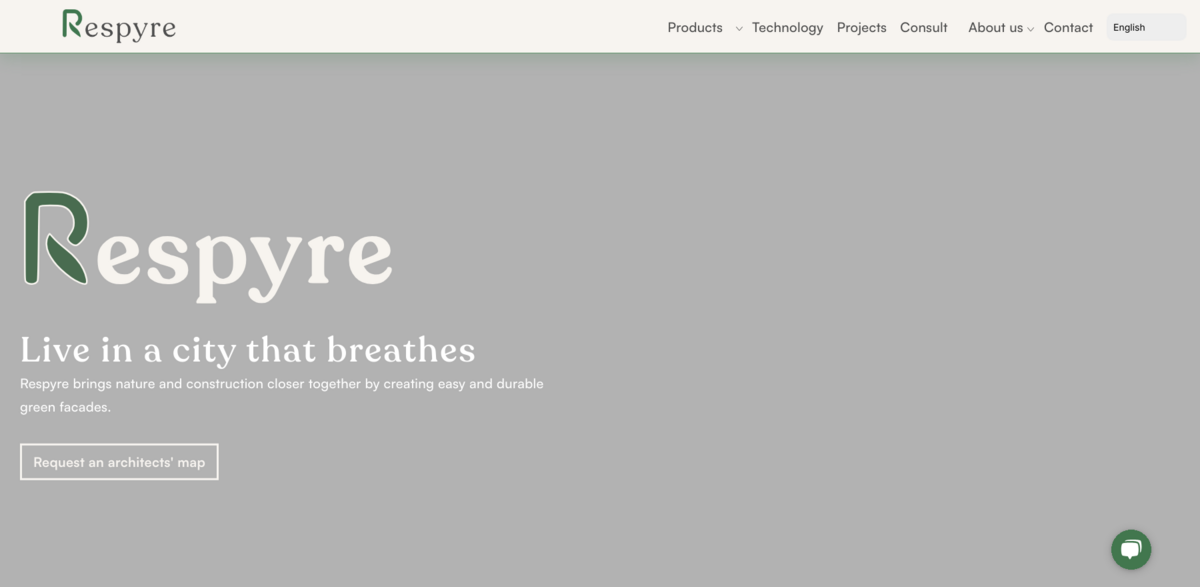What the Project Is All About
RESPYRE brings nature and construction closer together by creating easy and durable green facades. Urbanization is leading to growing cities and shrinking spaces for flora and fauna, which negatively impacts health, comfort, and the environment. Respyre’s innovative approach uses an upcycled, bioreceptive concrete that enables moss to thrive on both horizontal and vertical surfaces in urban areas. This technology transforms unused structures into green spaces, turning concrete walls and facades into living canvases that purify the air, reduce urban heat, manage water nuisances, and even lower noise levels. Originating from TU Delft, this bioreceptive concrete has been demonstrated successfully in labs and is now proving its worth in real-world applications… making it easier than ever for cities in need of nature’s embrace to achieve a healthier, eco-friendly future.
Main Benefit: Transforming Urban Spaces
- SQUARE METERS OF MOSS – visually captivating and functionally significant, green facades help tackle urban challenges
- KG OF CO₂ BEING ABSORBED – moss acts as a natural filter, removing CO₂ and other pollutants while generating oxygen
- PURIFICATION – improved air quality stands out as moss expertly converts CO₂ and NOx into clean, breathable air
- COOLING – lowering the urban heat island effect and reducing stress levels in congested city environments
The Science Behind the Green Transformation
Moss is not just about aesthetics – it plays a crucial role in supporting urban life. By naturally regulating air quality, moss turns harmful substances like CO₂ and nitrogen oxides into beneficial oxygen. This process is more than a chemical reaction; it’s an ecological transformation that brings life back into concrete jungles. The technology integrates recycled concrete aggregates with natural products to create a bioreceptive surface where moss can grow effortlessly. The result? A more vibrant, breathable atmosphere that offers cities a natural way to cleanse the air and enhance human comfort.
Addressing Urban Challenges One Green Facade at a Time
The pressures of urban living – from the urban heat island effect to water nuisances and incessant noise – have often made cities uncomfortable and unsustainable. Respyre’s approach to using bioreceptive concrete with a moss-coating is an answer to these pressing challenges. Not only does this method provide an elegant green cover, but it also serves as a practical means to moderate temperature extremes and reduce stress in crowded city centers. The moss coating acts as a buffer, absorbing pollutants and noise, thereby creating a microenvironment that is both healthier and more resilient. In doing so, it also extends the life of existing structures, proving that an eco-friendly solution can be as robust as it is innovative.
A Versatile Solution for Modern Cities
From facades to interiors, the adaptability of moss is remarkable. By applying Respyre’s bi-plaster or pre-fabricated panels, developers have the option to redesign existing building structures or create new, living structures entirely. This approach does not merely add beauty; it embeds nature into the fabric of urban design. The integration of natural elements into construction materials introduces the possibility of creating self-sustaining environments that can cope with climate change and urban stressors. At its core, the project is driven by the concept that green cities are not just idealistic but are indeed future-proof—a testament to innovation meeting the challenges of today’s ever-changing urban landscapes.
The Broader Impact on Urban Ecosystems
Green facades crafted with bioreceptive concrete create opportunities for ecological balance. Moss provides essential habitat for small insects, which in turn contributes to the overall biodiversity of urban settings. The added layer of nature on man-made structures supports a chain reaction of ecological improvements. Enhanced air circulation, higher oxygen levels, and a moderated urban climate all contribute to a more habitable environment for both humans and animals. Cities that embrace these natural innovations tend to witness a reduction in environmental stressors, making them not only greener but also more resilient in the face of extreme weather events.
Project Impact: Linked Sustainable Development Goals
- SDG 11: Sustainable Cities and Communities – creating green spaces that enhance urban living.
- SDG 13: Climate Action – reducing CO₂ levels and mitigating climate change impacts.
- SDG 3: Good Health and Well-being – improving air quality and reducing urban stressors.
- SDG 15: Life on Land – increasing urban biodiversity and providing habitats for small insects.
The Future of Urban Living
RESPYRE’s mission is straightforward but powerful: to turn green cities into the standard, not the exception. By harnessing the natural properties of moss combined with advanced construction techniques, urban areas can breathe a little easier—literally. Imagine cities where every unused surface has the potential to become a living, breathing part of the urban landscape… where green facades blend seamlessly with modern architecture to build a healthier, more sustainable future. This innovative solution is more than a fleeting trend; it signifies a pivotal step towards building urban environments that stand resilient against climate change and continue to support the well-being of all its inhabitants. The journey towards greener cities is underway, and each new moss-coated structure brings a promise of a brighter, more sustainable future.





















